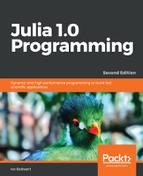Chapter 1, Installing the Julia Platform, explains how to install all the necessary components for a Julia environment. It teaches you how to work with Julia's console (the REPL) and discusses some of the more elaborate development editors you can use.
Chapter 2, Variables, Types, and Operations, discusses the elementary built-in types in Julia and the operations that can be performed on them so that you are prepared to start writing code with them.
Chapter 3, Functions, teaches you why functions are the basic building blocks of Julia, and how to effectively use them.
Chapter 4, Control Flow, shows Julia's elegant control constructs, how to perform error handling, and how to use coroutines (called Tasks in Julia) to structure the execution of your code.
Chapter 5, Collection Types, explores the different types that group individual values, such as arrays and matrices, tuples, dictionaries, and sets.
Chapter 6, More on Types, Methods, and Modules, digs deeper into the type concept and how it is used in multiple dispatch to get C-like performance. Modules, a higher code organizing concept, are discussed as well.
Chapter 7, Metaprogramming in Julia, touches on deeper layers of Julia, such as expressions and reflection capabilities, and demonstrates the power of macros.
Chapter 8, I/O, Networking, and Parallel Computing, shows how to work with data in files and databases by using DataFrames. It also looks at networking capabilities, and how to set up a parallel computing environment with Julia.
Chapter 9, Running External Programs, looks at how Julia interacts with the command-line and with other languages, and also discusses performance tips.
Chapter 10, The Standard Library and Packages, digs deeper into the standard library, and demonstrates important packages for the visualization of data.
